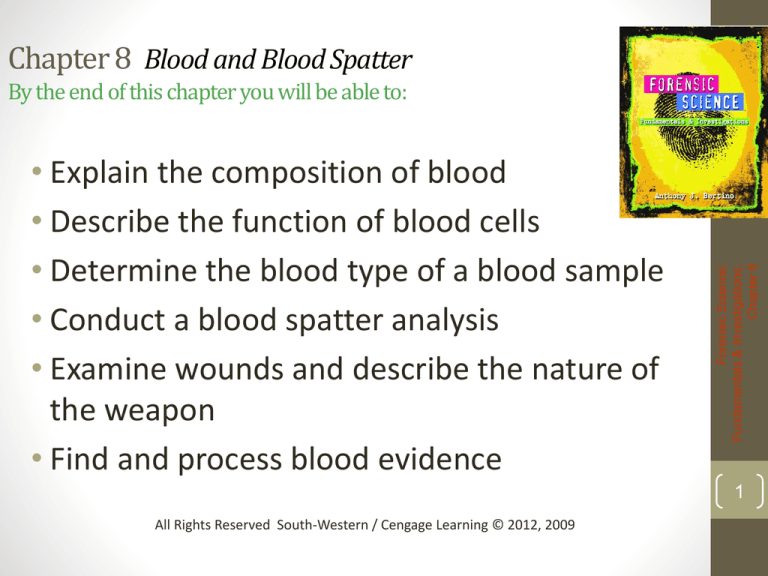
Chapter 8 Blood and Blood Spatter
• Explain the composition of blood
• Describe the function of blood cells
• Determine the blood type of a blood sample
• Conduct a blood spatter analysis
• Examine wounds and describe the nature of
the weapon
• Find and process blood evidence
Forensic Science:
Fundamentals & Investigations,
Chapter 8
By the end of this chapter you will be able to:
1
All Rights Reserved South-Western / Cengage Learning © 2012, 2009
Introduction and History
Forensic Science:
Fundamentals & Investigations,
Chapter 8
• Blood typing provides class evidence
2
Introduction and History
Forensic Science:
Fundamentals & Investigations,
Chapter 8
• DNA profiling provides individual evidence
3
• A blood spatter pattern provides
information
• the truthfulness of an account by a
witness or a suspect
• the origin of the blood
• the angle and velocity of impact
• the type of weapon used
Forensic Science:
Fundamentals & Investigations,
Chapter 8
Introduction and History
4
Forensic Science:
Fundamentals & Investigations,
Chapter 8
Composition of Blood
5
Forensic Science:
Fundamentals & Investigations,
Chapter 8
Composition of Blood
6
Composition of Blood
Forensic Science:
Fundamentals & Investigations,
Chapter 8
• Plasma—a liquid suspending other blood
components
7
Composition of Blood
Forensic Science:
Fundamentals & Investigations,
Chapter 8
• Red blood cells (Erthrocytes)—carries
oxygen to the body’s cells and carbon
dioxide away
8
Composition of Blood
Forensic Science:
Fundamentals & Investigations,
Chapter 8
• White blood cells (Leukocytes)—fights
disease and foreign invaders and, alone,
contain cell nuclei
9
Composition of Blood
Forensic Science:
Fundamentals & Investigations,
Chapter 8
• Platelets—aids in blood clotting and the
repair of damaged blood vessels
10
Composition of Blood
Forensic Science:
Fundamentals & Investigations,
Chapter 8
Can you identify the different
blood cells?
11
Forensic Science:
Fundamentals & Investigations,
Chapter 8
Types of Blood Cells
12
Forensic Science:
Fundamentals & Investigations,
Chapter 8
Cellular Components of Blood
13
Blood Typing—Proteins
Forensic Science:
Fundamentals & Investigations,
Chapter 8
• Discovered in 1900 by Karl Landsteiner
14
42%
12%
3%
of the population in the United States
43%
Forensic Science:
Fundamentals & Investigations,
Chapter 8
Blood Typing—Proteins
15
Rh System
• 1940, Alexander Weiner found a
protein common to his rhesus
monkeys and to some humans. It was
called the Rh protein.
Forensic Science:
Fundamentals & Investigations,
Chapter 8
Blood compatibility
18







